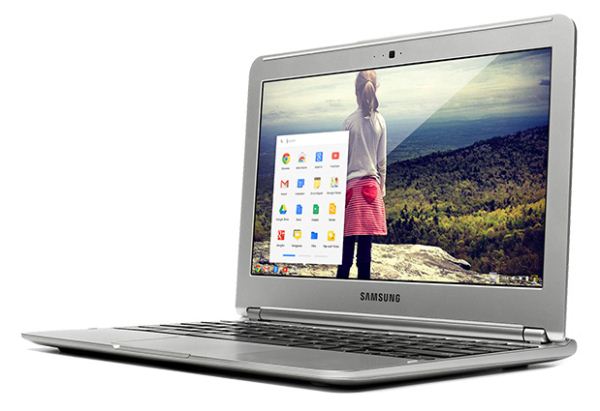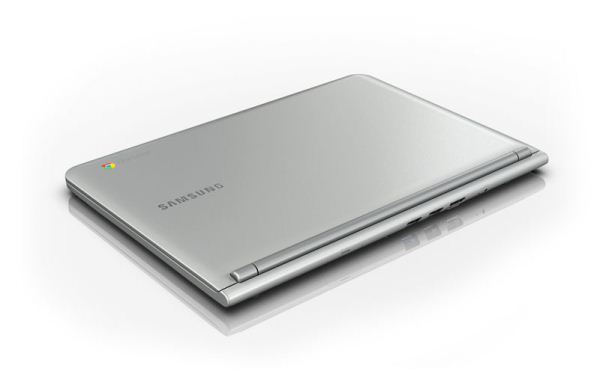Google Reboots The Chromebook: ARM Meets Notebook For $249
by Jason Inofuentes on October 18, 2012 10:11 PM EST- Posted in
- Laptops
- Samsung
- Chrome OS
- Exynos
- Chromebook
- Exynos 5 Dual
Google's been known to throw the spaghetti at the wall to see what sticks. And for every GMail and Android, there's a Wave and Buzz. At best, Google's Chromebook initiative is valiantly clinging to the wall, lost ground not withstanding. Today, they've unveiled their latest Chromebook collaboration with Samsung, and it's frankly quite exciting. The 11.6" notebook weighs in at just 2.5 lbs, and gets to be the first device sporting Samsung's Exynos 5 Dual (5250). Sound familiar? That would be the first ARM Cortex-A15 SoC to show up in a commercially available device, and the first potentially mainstream ARM based PC to hit the market.

The rest of the specs are relatively modest, the 11.6" panel has a respectable 1366x768 resolution, a VGA camera, SD card slot, one each USB 3.0 and USB 2.0 ports, and an HDMI port. Bluetooth and WiFI are built-in, though this generation foregoes the 3G modem of the first Chromebook. Some noise has been made about the quoted 6.5 battery life; we've never taken too much stock in PR provided data. The Cortex-A15 can be a power hungry SoC when stressed, and there's no details on battery capacity, so we'll have to handle the hardware ourselves to size up the battery life.
The SSD is a zippy but small 16GB, but local storage isn't really the point of a cloud-centric Chromebook. And to help allay storage fears, Google's including 100GB of Google Drive capacity for 2 years, with the the purchase of the $249 laptop. That additional cloud storage sweetens the value of the device, too; paying for the service out of pocket would cost $120 over the two year span. So, is this the Chromebook that will finally win us over? We'll find out soon, preorders start today, and sales start Monday.
Update: Turns out a 3G option is available, though unannounced. Service is included in the cost of the device for 2-years, up to 100MB a month, and is provided by Verizon. The 3G SKU will cost you $329, and is available for pre-order now.
Also, I misspoke on the matter of this being the first ARM based PC, I hope the edit adds some clarity.
Source: Google

















50 Comments
View All Comments
frostyfiredude - Thursday, October 18, 2012 - link
I've read that it's a 30Wh battery on G+ and Engadget. That 6.5 hour runtime doesn't sound very good to me for a 11.6" ARM device with that size battery. My 11.6" MBA with a SB i5 gets 5 hours off a 35Wh battery while browsing the web for comparison, and that's with a heavier OS at that.coder543 - Thursday, October 18, 2012 - link
If anything, I'd say they're being safe rather than sorry by quoting such a low number. My bet is that this device averages 8 hours minimum...however, if we set my assumptions aside and consider your argument, I will point out that the MBA has four times the budget to put into each component, allowing them to fine tune each component to use as little power as possible, and the battery is LiPo instead of Li-Ion, plus a better quality display panel can draw significantly less power. The same could be said to a lesser extent of WiFi and Bluetooth.
Apple is a master at their craft.
I can't wait for full reviews of this device, and I so wish that I could run Ubuntu for ARM or some other ARM distro on here. We'll see.
Kisper - Friday, October 19, 2012 - link
Just to clear things up:lithium polymer batteries ARE lithium-ion.
The major difference is that in a traditional Li-ion battery, the electrolyte (a lithium salt) is held within an organic solvent, whereas with a Lithium-ion polymer battery, the electrolyte is held by a polymer.
I agree in principal with your statements. Hopefully you don't construe this to be an attack on you.
teldar - Saturday, October 20, 2012 - link
According to modern convention, while a lithium polymer battery may indeed be a lithium ion battery, people refer to advanced polymer batteries as polymer and more generic lithium batteries as ion.I appreciate specificity, as it's the only way to preclude misinterpretations, but I would say he used typically accepted wordage.
Leonick - Saturday, October 20, 2012 - link
Possible. Can't say I know the last time I saw a product where the battery estimates undercut the actual time you get. Apple usually got fairly spot on with their, most other companies exaggerate a lot (or simply don't test under reasonable conditions).Heck if Samsungs phone battery life specs are anything to go by you should be happy if it comes anywhere near those six hours even :p
UpSpin - Friday, October 19, 2012 - link
30Wh/6hours = 5W for the Chromebook35Wh/5hours = 7W for the MacBook Air
The display backlight consumes most of the power. Both have the same display resolution, thus equal display backlight, thus their display should consume about the same power. Most of the other internals consume similar power, too. The SSD in the Macbook air idles while web browsing so no real difference here either, the Air has more RAM, but the difference is maybe 0.2W in the end. So 2W more for the SB i5 while idling, sounds reasonable for me.
We also don't know how Google measured the battery life. While idling, web browsing, movie playback, what display brightness?
So better wait for reviews to see make a real comparison.
lowlymarine - Friday, October 19, 2012 - link
It's called "race to idle." While the SB i5 in your MacBook Air uses a lot more power under load than a Cortex-A15, it's also leaps and bounds more powerful. Therefore, it gets its work done faster and returns to the all-important idle state sooner, allowing for better battery life in a simple workload like web browsing.Put both machines under continuous load until the batteries died, and I'm sure the ARM notebook would last a fair bit longer. Then again, it would also get less done.
Microsapper - Thursday, October 25, 2012 - link
Chromium Browser is being fully optimized for online use on ARM A15. The mainboard design, bandwidth, i/o, power usage, SSD are being optimized for this purpose as well. The SSD powers down and A15 throttles down for online use to save on Mali 605 GPU power usage. While doing general web browsing, we can expect to get much longer power usage and that's what they've been shooting for with this first ARM powered Ultrabook!Charbax goes into additional details on his ARM page, in explaining just how Cloud Computing is set to change our Online Connected World in the Future with Chrome OS:
http://armdevices.net/2012/10/21/how-i-think-that-...
Charbax has been on the cutting edge of ARM computing for years. He was the first to get a look at Samsung's F700 in August September and is mostly the one who leaked photos in early October. He described SGH-Z610 (FCC in August 2006) as the precursor to the Apple iPhone, when it was first shown in January 2006. A whole year before iPhone came out. No doubt he has direct connections inside Samsung. Even Apple was aware of this Multi-media Touchscreen Gesture Based Smartphone w/ it's single round physical Play/Home button on front. In fact they used the processor in iPhone. Anyone smart should pay attention to what he says and there is absolutely no doubt about that! (even though he has toned down his leaks in recent years, he still gets inside info)
Consider this; at $249 the Samsung ARM Chromebook is an excellent deal and no doubt, at this early stage has lots of room to be optimized and you may find some of his claims a little too outrageous. But he's made them before and been right the majority of the time. Right now that future 20 hour usage on this ARM A15 Ultrabook may sound ridiculous, but we haven't seen even half of what ARM and Samsung have put into the Exynos Processor.
Remember too..... that had Samsung a8 Inte gone with ARM's recommendation and dropped Intrinsity inside of deciding to o partner with Apple on Hummingbird share the costs when Intrinsity was in dire financial straits and over the due date, they would have been better off. ARM would be too, because they wanted SAMSUNG to be first to build an all ARM Chip with Mali GPU, Artisan, etc. But wanted energy efficient CPU to go with Imagination GPU for power to run iPad. ARM was having trouble getting any fab or device maker to take a shot on Mali. Low n behold SAMSUNG should have dropped Apple and Intrinsity...... eaten their losses and Gone all ARM then! .......ARM Logic Energy Efficient design Optimizations were every bit as good as Intrinsity's
nerd1 - Friday, October 19, 2012 - link
I own a MBA 13" with (claimed) 7-hr battery time and I usually get 4.5hrs. What I do is mostly browsing, yes with flash enabled.amdwilliam1985 - Monday, October 22, 2012 - link
Pretty much the same here with my 2011 13" base MBA.I get about 5 hours of browsing with pretty much everything turn off and/or lower.